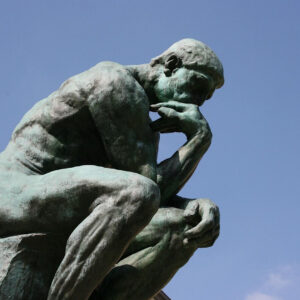One of the most striking aspects of yogic philosophy is the teaching that the mind is not, in itself, conscious. The mind is an insentient reflector of consciousness. Its activity reflects consciousness in somewhat the same fashion that the activity of a compass reflects the presence of magnetic impulses. In the West, we tend to believe, cogito, ergo sum, “I think, therefore I am.” To the yogi, thoughts actually cloud the essence of who “I ” am. The quest for realization is an effort to go beyond thought, beyond the conditioned mind, to experience the source of consciousness. Spirituality begins where thought ends.
According to yogic philosophy, consciousness is of the nature of a pure “I” sense. As this “I” associates with different forms of insentient nature, such as the body and mind, these forms appear to be independently conscious. In fact, the body does not walk, the breath does not breathe, the mind does not think without the presence of the activating consciousness.
There is a famous Zen question, “Is the taste of tea in the tea leaves, or in the tongue?” In other words, does one’s experience of the world arise as a result of external stimuli or from the internal response? From a yogic perspective, the taste of tea is a collaboration between the tea and the tongue. As Claude Bragdon put it, our experience of the world is a collaborative effort of both receptivity and creativity.
The collaboration resulting in our experience of the world goes something like this. First, the senses receive stimuli from the external environment, conveying this information to the mind. The mind then translates this information into cognizable forms, and later colors this neutral information with personal biases. Take the example of a person looking at a sunset. The eyes see a form of mass, light, and color. This pure stimulus received by the eyes is sent to the part of the mind, called manas, which collates sensory information. Manas replicates, to the best of its ability, the impressions fed by the senses, reproducing an image of the external world. In this case, an image of the sunset. The intellect, or buddhi, then identifies the perception: “This is a sunset.” The final pronouncement is made by the ego, called, ahamkara, which is essentially judgmental. It proclaims the sunset good or bad, pleasurable or painful, acceptable or unacceptable (and other sets of the pairs of opposites) based solely on personal inclination.
The nature of one’s reality is highly personal, vastly subjective. Everyone’s mind and senses, just like fingerprints, are different. In addition, the external world is always in a state of flux. Every single perception is sole and unique, arising from the interchange between an individual’s one-of-a-kind mind and senses (the perceiver) and a once-in-a-moment external world (the perceived).
No two living beings experience the world identically. In general terms, human minds experience a certain range of sensory data whose parameters are relative to other living creatures. We see fewer colors than bumblebees, for instance, and we have a smaller range of hearing than cats. In more specific terms, one’s human ego apprehends the world relative to those of other human egos. What one person deems beautiful and interesting is to another person hideous and a waste of time. This is why there is such vast disagreement as to what is attractive, what is art, what is socially acceptable, and what is moral.
Some Eastern systems terminate with this analysis of perceiver and perceived and conclude that all is ephemeral and that there is no axis upon which changing perceptions revolve. Devotional schools of yoga go further; they say there exists an Absolute Reality that is eternally present as the underlying basis of all transient, individual experiences. There is an Absolute Consciousness, Awareness, and a Divine Center, from which the universe arises and by which it is sustained. It is this ocean into which the many rivers of individual experience flow. It is this Supreme Consciousness which we call God.
We honor God, transcendent, and immanent when we say “namaste.” Namaste is a traditional Indian greeting which means: when you go deeply enough into your consciousness and I go deep enough into mine, we find that we are One. This One appears as many in the realm of mind and senses, but on a deeper level, all things are united in the One. This One is the source, sustainer, and eventual completion of all forms. We can never leave our source because our source is always with us, as us.
Our problems arise because we feel ourselves separate from the One, from God. From the standpoint of the suffering human being, this separation feels tragic. From the standpoint of the One, the separation is illusory. How can the waves ever be separate from the ocean?
Through spiritual practice, we can quiet the tumultuous distractions in our minds, and deeply feel in our hearts the reality of the unity of consciousness. Then our separative suffering naturally evaporates, like clouds before the warmth of the sun. Life ceases to be an existential burden, and we awaken to discover ourselves interconnected with all living beings. Everywhere, in all forms and beyond form, is the One found expressing the purpose of divine love. Namaste.




